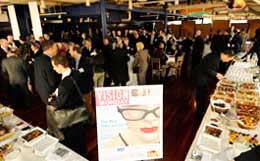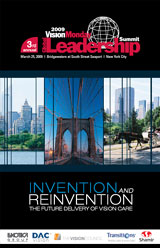VM's Global Leadership Summit
NEW YORK—For an in-depth look at the future delivery of vision care, plus insights on how the current economic environment impacts the eyewear/eyecare industry, more than 280 key optical retailers, eyecare professionals, suppliers and other industry executives gathered here Wednesday at the third annual Vision Monday Global Summit: Invention and Reinvention.
The event—organized by VM and sponsored by Luxottica Group, Transitions Optical, DAC Vision, Shamir and The Vision Council—featured speakers offering a broad spectrum of expertise in optical and related fields. Topics ranged from the independent's perspective to the links between eyecare and health care, from Internet technology to Wall Street's view of the optical business.
The Summit kicked off with a look at how independent ECPs and retailers confront the industry's mounting challenges. Glenn Ellisor, OD, president and chief executive officer of Vision Source, and Bobby Christensen, OD, Vision Source's senior vice president, outlined the 1,920-unit franchise group's growth since its founding in 1991, to its current level of $1.3 billion in aggregate sales last year. Said Ellisor, "Our mission is to assure the independence of private-practice optometry—private practice offers among the highest quality of eyecare that can be had."
 |
Attendees gathered for coffee before the Summit kicked off. |
Characterizing the typical Vision Source member as "the neighborhood eyecare providing specialized services for the patient," Christensen said the group achieved same-store growth of 6.2 percent in 2008, "and this year so far our growth is remaining about the same" despite the economy.
Diana Hall, CEO of Peoria, Ill.-based Bard Optical, outlined steps she is taking to keep her 18 stores healthy after record 2008 sales of more than $10 million. Noted Hall, "I can't control w hat happens globally, but I can control how I react to it."
She said Bard is adding new products such as free-form progressive lenses, "renegotiating everything" with landlords and suppliers, and focusing more on the medical side of optometric care. "This is the time to turn yourself inside-out, not just do what you've always done," she declared.
Peter Kehoe, OD, president of the American Optometric Association (AOA), addressed the changing definition of "independent," saying, "An 'independent' is not necessarily in a traditional private practice—an OD can be independent in any setting." Noting that consumers are "a little confused about what we do as ODs and what optometry is all about," Kehoe told of the AOA's efforts to raise optometry's profile and scope of practice, and the link between vision care and general health care.
Jeff Johnson, OD, a senior financial analyst with R.W. Baird, outlined the financial community's view of the optical industry and the recession's impact on eyecare stocks. Said Johnson, "So far in 2009 the broader [stock] market remains weak. The ophthalmic sector is also soft, but is outperforming the broader market."
Looking at how the Internet provides consumers information about eyewear and eyecare, Ron Walker, CEO of AllAboutVision.com, said using the Web f or health education is growing fast. "Of American adults online, 80 percent have searched the Internet for health information," including eyecare, Walker noted, saying his site should serve nine million visitors this year.
As for online eyewear purchasing, Dhavid Cooper, OD, co-founder and CEO of FramesDirect.com—which hosts 30,000 new visitors daily—declared, "The Web is not necessarily about price—it's about convenience." He said the site's innovations include its FrameFinder virtual try-on technology, mathematical calculations for finding seg height for progressive lenses and its Smart Sun tool for Rx sunwear.
In an afternoon panel discussion on "Future Delivery of Retail and Health Care," Kerry Bradley, president of Luxottica Retail, North America,
urged the industry to work together to increase the overall size of the eyewear/eyecare "pie" rather just competing to get a larger slice of the
existing market. "I'm optimistic the industry is at a place where we'll grow the size of the pie, so that three years from now the problem will be
how we can take care of all those people," he said.
Bradley urged the optical industry to unite behind—and invest in—a unified industry message stressing to both consumers and employers the
importance of regular eye exams, "to lead them to the way they should think about eyes."
Predicting it may be 2010's second half before the economic environment improves significantly, David Holmberg, president and CEO of HVHC and chairman, president and CEO of its Eye Care Centers of America chain, addressed expected reforms in U.S. health care. He said, "As soon as the market improves, the next train coming down the track will be health-care reform—without a doubt we're going to see a change." Holmberg also said many different entities will be fighting for the consumer's health-care dollar, "and it's important to make sure we [in eyecare] get our share."
Looking at consumers' view of eyecare, Rob Lynch, president and CEO of VSP, stressed, "It's important to relate the importance of annual eye exams to good health." Lynch said VSP research indicates that every dollar spent on an eye exam produces 94 cents in savings in avoided medical costs and improved job performance. As for the economy, "we've planned for a tougher 2009," Lynch said. After about 9 percent growth in 2008, "we've planned for 4 percent to 4.5 percent growth this year, although the first couple months of 2009 were well above that."
Jeff McAllister, senior vice president of health and wellness operations for Wal-Mart Stores, which operates more than 3,000 in-store vision centers, also stressed the importance of eyecare to health, saying, "The opportunity we have is beyond a business opportunity—it's to demonstrate the need for eyecare as people enter the stage of life when they need it the most." As for the economy, "our customers are thinking about their finances, the weakening economy, the cost of living and possible job loss," McAllister said. "That's creating uncertainty, and people are making sure they're trading into what's appropriate for them."
Barry Barresi, OD, executive director of the AOA, challenged the managed-vision industry's reimbursement levels for ODs, asking, "Are vision plans broken and need to be replaced?" He said, "The optometric profession has changed dramatically" in terms of scope of practice, "but has the payment system kept pace, or is it a barrier for the pie to expand?" Barresi said the first step in reforming managed vision would be "full transparency and disclosure" so ODs can make informed decisions on which plans to join.
Following the panel discussion, questions from the audience touched on a variety of topics, such as how government and employer forces are changing managed vision, how panelists view this year's economic challenges and how the industry can work together on a shared message on eyecare.—Cathy Ciccolella

